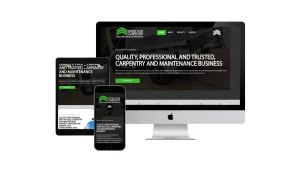Revitalise Your Online Presence: A Comprehensive Guide to Crafting a Winning Website Redesign Strategy for Your Business
In today’s cutthroat business environment, a finely-tuned website isn’t a luxury; it’s an absolute necessity for sustainable growth and success. In the year 2023, your website often serves as the initial point of contact between your brand and potential customers. An outdated website can erode your credibility, while a professionally designed one can significantly bolster it.
As technology evolves and customer expectations shift, your website must evolve in tandem. Maintaining an up-to-date website that aligns with your business objectives necessitates a well-crafted website redesign strategy.
When Is a Website Redesign Necessary?
Your business website is more than just an online presence; it’s a potent marketing tool capable of either enhancing or diminishing your brand’s image. But how do you discern when it’s time for a website makeover?
Several indicators signal the need for a website revamp, including outdated design elements, dwindling website traffic, subpar search engine rankings, or a high bounce rate. Additionally, your website might warrant a redesign if it lacks mobile-friendliness, suffers from sluggish loading times, or no longer reflects your current business strategy.
If you’re uncertain about the necessity of a redesign, conducting a comprehensive website audit can provide the clarity you seek. A thorough examination of your website can pinpoint areas where a redesign could dramatically bolster your digital footprint.
It’s essential to recognize that a website redesign entails more than just a cosmetic facelift. It’s a holistic process that involves enhancing functionality, user experience, and alignment with your business objectives.
What Constitutes a Website Redesign Strategy?
A website redesign encompasses the process of enhancing, repairing, or repositioning a website with the primary goal of increasing traffic, engagement, and revenue.
Effectively executing a website redesign project necessitates a meticulously crafted strategy. This strategy involves defining your business objectives, comprehending your target audience, and evaluating your current website’s performance.
To begin, you must have a clear vision of what you aim to accomplish with the redesign. Do you intend to boost website traffic, enhance user experience, or perhaps rebrand your business? Well-defined objectives enable the development of a focused plan that aligns seamlessly with your overarching business strategy.
Next, understanding your audience is imperative, as your website is designed to cater to their needs and preferences. Analyzing your audience’s behavior, preferences, and feedback yields valuable insights that inform the redesign process.
Finally, evaluating your current website assists in identifying areas in need of improvement. This evaluation encompasses an assessment of your website’s design, content, usability, and SEO performance. Consider elements such as branding, navigation, typography, colors, copy, images, icons, page layouts, call-to-action elements, contact forms, and user journeys. By identifying what’s effective and what isn’t, you ensure that your new website not only looks better but also performs better.
Designing a Seamless User Experience
Initiating Your Website Redesign Planning
Commencing a website redesign necessitates a well-defined strategy, with the initial phase holding pivotal importance as it sets the course for the entire project.
- Review Your Current Website: Begin by conducting a comprehensive review of your current website. This process entails a meticulous assessment of its strengths and weaknesses, helping identify issues that require attention during the redesign. Tools such as Google Analytics and Google Search Console can provide valuable insights into your website’s performance.
- Set Website Benchmarks: Benchmarking involves measuring your website’s current performance to create a reference point. This is critical for understanding the impact of your redesign upon completion. Metrics to track might include page views, average session duration, bounce rate, conversion rates, and user engagement. Tools like Google Analytics, Ahrefs, or Semrush can generate comprehensive reports for benchmarking.
- Establish Clear Redesign Objectives: Once you grasp your current website’s performance, it’s time to define your objectives for the redesign. Setting clear, measurable goals keeps your project on track and provides a means to evaluate success. For instance, your objectives might include reducing the website’s bounce rate by 15%, increasing the conversion rate by 10%, or boosting average session duration by 20%. Align these goals with your broader business strategy for a successful redesign.
Understanding Your Audience
At the heart of every successful website redesign lies a comprehensive understanding of your website’s audience. To craft a website that resonates with your users, you must grasp their needs, preferences, and behaviours.
- Conduct User Research: User research is a potent tool for unearthing insights about your audience. It aids in comprehending who your users are, what they require, and how they interact with your site. You can conduct this research through online surveys, interviews, or analytical tools that track user behavior.
- Develop User Personas: Based on your research, create user personas – hypothetical profiles of your ideal customers. Each persona should encompass demographic details, goals, preferences, and behavioral patterns. This facilitates understanding and catering to the needs of your key audience segments. For example, one persona might depict a busy professional valuing efficiency and concise content, while another might represent a tech-savvy user appreciating innovative features and interactive design.
- Create a User Journey Map: A user journey map visualizes the steps a user takes to achieve a goal on your website. This provides insight into how your audience interacts with your site, what motivates them, and where potential obstacles to their goals may exist. Understanding your audience ensures that your website redesign meets their expectations, ultimately improving user experience and increasing conversions.
Analysing Competitor Websites
A crucial facet of a successful website redesign strategy involves analyzing your competitors. By discerning what your competitors are doing right (and wrong), you can glean insights to guide your redesign process and distinguish your website in a crowded marketplace.
- Identify Your Competitors: Begin by identifying your primary competitors, which could include businesses offering similar products or services or occupying the same industry niche. Keep in mind that competition may also arise from indirect competitors or substitute products addressing the same customer problem.
- Review Competitor Websites: Much like how you scrutinized your own website, critically assess your competitors’ websites. Examine their site structure, design, content, and overall user experience. Identify their strengths and weaknesses.
- Establish Competitive Benchmarks: Utilizing the information gathered in the previous steps, create benchmarks based on your findings, similar to the benchmarks you established for your own website. If a competitor boasts a two-second load time, aim to match or surpass it in your redesign. If they offer a clean, intuitive navigation, aspire to attain that standard. By benchmarking against competitors, you bolster your website redesign strategy and strive for excellence in areas where they excel.
- Learn From Their Mistakes: Finally, leverage your competitors’ shortcomings to your advantage. If you observe high bounce rates or inadequate mobile optimization on a competitor’s website, ensure your redesign addresses these issues. Thorough competitor analysis equips you with valuable insights to inform your redesign process, positioning your website to stand out from the crowd.
Website Structure & Design
A significant portion of your website redesign project revolves around the site’s structure and design, elements that directly influence user experience and can make or break your online presence.
- Review Your Website’s Structure: A website’s structure, also known as information architecture, pertains to how its pages are organized and interconnected. A well-designed structure enhances usability, improves SEO, and facilitates conversion. Like your initial website review, scrutinize your current structure objectively. Ensure users can easily find what they seek and that the content flows logically. In your redesign, aim to create a structure that is intuitive and user-friendly, reducing the number of clicks required to reach the desired destination.
- Focus on User Experience (UX): User experience plays a pivotal role in shaping visitors’ perceptions and interactions with your website. A superior UX design anticipates user needs, delivers value, and fosters seamless interactions. Elements such as load time, mobile responsiveness, and usability are paramount, as identified during the benchmarking process. Your redesigned website should excel in these areas.
- Prioritize Mobile-Friendly Design: Ensure that your website redesign incorporates responsive design, which automatically adjusts layout and content based on the user’s device. Mobile responsiveness is no longer optional; it’s imperative. Consider this factor when setting objectives for your redesign, as a high-performing website must cater to users on all device types.
Crafting a Content Strategy for Website Redesign
Your website’s content is the substance that makes your site valuable to visitors. It’s not solely about design and user experience; it’s about what your website communicates.
- Set Content Goals: Similar to establishing clear objectives for your website redesign, you must do the same for your content. Determine the purpose of your content: to inform, entertain, persuade, or a blend of these objectives. Align your content goals with your overarching business strategy. For instance, if lead generation is a target, gear your content toward attracting and converting potential customers.
- Plan Your Content: Once you’ve defined your content goals, commence planning your content. Consider creating a content calendar to organize and schedule content creation and publication. Diversify your content types, encompassing blogs, videos, infographics, and more, to sustain audience engagement and interest.
- Consider SEO: Recognize that part of your website redesign aims to enhance visibility on search engines. Optimize your content for SEO, incorporating appropriate keywords, creating quality backlinks, and ensuring valuable and shareable content.
Managing the Timeline, Budget & Project
In any redesign project, it’s imperative to set realistic expectations regarding the timeline, budget, and project management. These three facets are intertwined and constitute essential aspects of your overarching website redesign strategy.
- Timeline: The timeline for your project hinges on its complexity. Minor updates may take a few weeks, while a complete website overhaul could span several months. Always factor in additional time to address unforeseen issues or adjustments.
- Budget: Determining a budget for your website redesign may present challenges, but it’s a crucial step. Your budget should encompass all aspects of the redesign, including design and development costs, content creation, SEO optimization, and potentially the expense of hiring a professional agency. Keep in mind that a higher initial cost may yield long-term benefits by enhancing user experience, boosting SEO, and increasing conversions.
- Project Management: Managing a website redesign project can be intricate, entailing coordination across multiple teams and tasks while ensuring adherence to timelines and budgets. Many businesses opt to work with a professional web design agency to manage their redesign projects. If you’re managing the project internally, consider utilizing resources for writing a website brief to define your project, set clear objectives, and effectively convey your vision, streamlining the redesign process.
Testing, Launch & Post-Launch Strategy
Each phase of your website redesign strategy holds significance, but the testing, launch, and post-launch phases are particularly critical in determining project success.
Testing:
- Testing is a pivotal stage that should not be rushed. Ensure that every aspect of your website functions as intended, encompassing performance testing to assess loading speeds, usability testing to gauge the user experience across devices and browsers, and SEO testing to verify proper implementation of SEO elements like meta tags, URL structure, and internal links.
Launch:
- The launch phase is a momentous occasion, but it’s more than just flipping the switch. To ensure a smooth website go-live, consider factors such as scheduling the transition during periods of lower traffic, verifying that your hosting service can accommodate the new site, and devising a marketing and promotional strategy to draw attention to your improved website.
Post-Launch Strategy:
- Your website redesign strategy shouldn’t culminate at launch. The post-launch phase is where you monitor your website’s performance against the benchmarks established earlier in the redesign process. Employ analytical tools to measure metrics like bounce rate, page views, conversion rates, and average session duration. By comparing these metrics to your benchmarks, you can assess whether your redesign has achieved its objectives. Collect and incorporate user feedback to make necessary tweaks, as a website redesign is an ongoing process requiring regular updates and optimizations to meet user expectations and business goals.
Frequently Asked Questions:
Q. How often should I redesign my website?
A. The ideal frequency for a website redesign depends on your business needs and user expectations. Generally, a redesign every 2-3 years keeps your site fresh and competitive.
Q. How long does a website redesign process typically take?
A. The timeline for a website redesign project can vary widely based on the size and complexity of the site, your objectives, and resources. A small to medium-sized business website redesign can often be completed within 2-3 months.
Q. How can I ensure my website redesign improves my SEO ranking?
A. A successful website redesign should always take SEO into consideration. This involves maintaining your current SEO strengths, addressing weaknesses, and incorporating new SEO tactics. Using an SEO specialist during your redesign process is often beneficial.
Q. How do I avoid website downtime during a redesign?
A. Minimising downtime during a website redesign can be achieved through proper planning, especially regarding the launch phase. This can involve scheduling the transition during low-traffic times and ensuring your hosting setup is correctly configured.
Q. Can I do a website redesign by myself?
A. While it’s possible to redesign a website yourself, hiring a professional team can often save you time and ensure a higher-quality result. Professional web designers have the expertise to handle all aspects of the redesign process, from planning to launch and beyond.
In Conclusion:
Redesigning a website may seem daunting, but with a well-considered strategy, it becomes a manageable and even exciting project. Whether your aim is to enhance user experience, align with evolving business goals, or rejuvenate your online presence, a website redesign represents an investment in your business’s future.
We trust that this guide has illuminated the process, breaking it down into manageable sections and demonstrating that, with the right planning, success is entirely achievable. To your future success!




